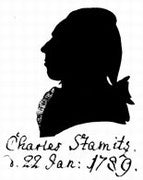Stamitz, Carl (1745 - 1801)
 |
Carl Philip Stamitz is the best-known representative of the second generation of composers who were active at the court of the Elector Palatine in Mannheim during the middle decades of the Eighteenth Century. He received his earliest musical training from his father, Johann Stamitz, Director of Instrumental Music and leader of the incomparable Mannheim court orchestra, and in the years following his father's early death, from the court musicians Christian Cannabich, Ignaz Holzbauer and Franz Xaver Richter. Extant orchestral registers for the period 1762-1770 list Carl Stamitz as a second violinist in the court orchestra, a position which enabled him to forge a brilliant performing technique as well as study the contemporary Mannheim repertoire. Stamitz left Mannheim in 1770, travelling to Paris where, the following year, he was appointed court composer to Duke Louis of Noailles. In Paris he made contact with many leading musicians including Gossec, Leduc, Beer and Sieber, who published a number of his newest compositions, and, together with his brother Anton, was a regular performer at the Concert Spirituel. In the summer of 1772 Stamitz lived at Versailles and composed the first of several programme symphonies, La promenade royale. His journeys as a virtuoso took him to Vienna in 1772, to Frankfurt the following year and in 1774, to Augsburg, Vienna and Strasbourg where he published the six quartets op.14. Stamitz's departure from Paris has not been accurately documented although Pohl claimed that he was in London from 1777 until at least 1779. The Paris years were secure and relatively prosperous for Stamitz. After his departure, however, he never again held an important permanent position even during the years of his greatest international fame. In London he published many compositions, especially chamber works, and continued to style himself 'Composer to the Duke of Noailles'. Some time after 1779 he moved to The Hague where he appeared as a viola soloist in at least 28 concerts at the Court of William V of Orange including one on 23 November 1783 in which Beethoven (aged twelve) played the fortepiano. During the next few years Stamitz travelled incessantly, presenting academies in Hamburg, Luebeck, Magdeburg, Leipzig and many other centres. He directed a performance of Handel's Messiah at the Cathedral in Berlin in 1786 and in 1787 was in Nuremberg for a performance of his musical allegory on the occasion of Blanchard's balloon ascent. Stamitz's last years followed much the same pattern as the decade immediately following his departure from Paris. He travelled extensively, made occasional petitions for employment and sent his compositions as far afield as Wales and Russia in the hope that they would win him lucrative compensation. In the mid-1790s he served briefly as Kapellmeister and music teacher at the university in Mannheim but the income was insufficient for him to support his family. His wife of ten years, Maria Josepha (née Pilz) died in January 1801 and Stamitz himself died in November the same year shortly before his planned trip to St Petersburg received official sanction. In spite of his early fame, his obvious gifts as a performer and composer and his sporadic experiments in alchemy, Carl Stamitz died so heavily in debt that his possessions had to be auctioned to help pay his creditors. A printed catalogue of his music collection was printed for a separate auction in 1810 but the collection has long since disappeared. Buy sheet music editions and PDF files of music by Carl Stamitz |


